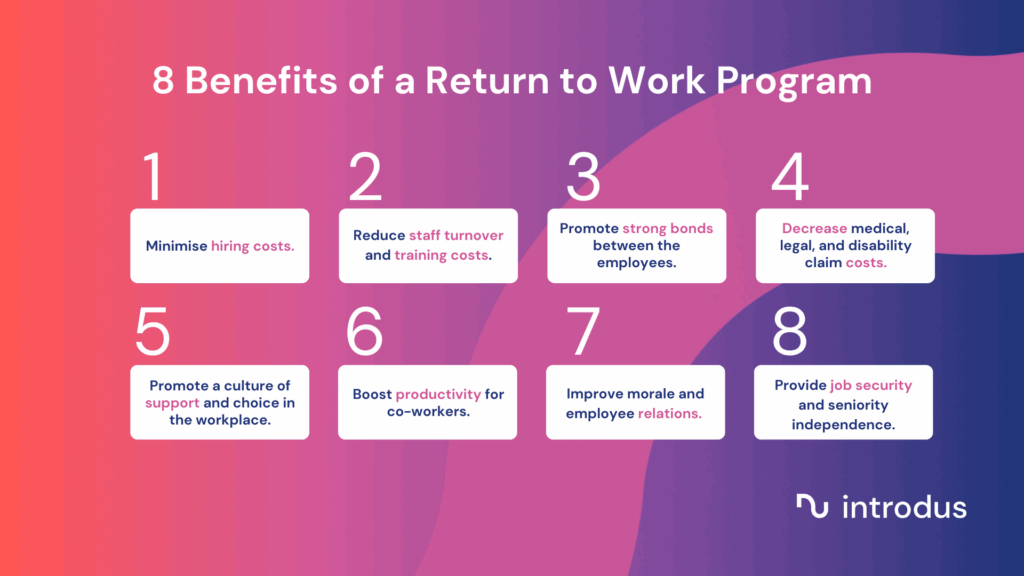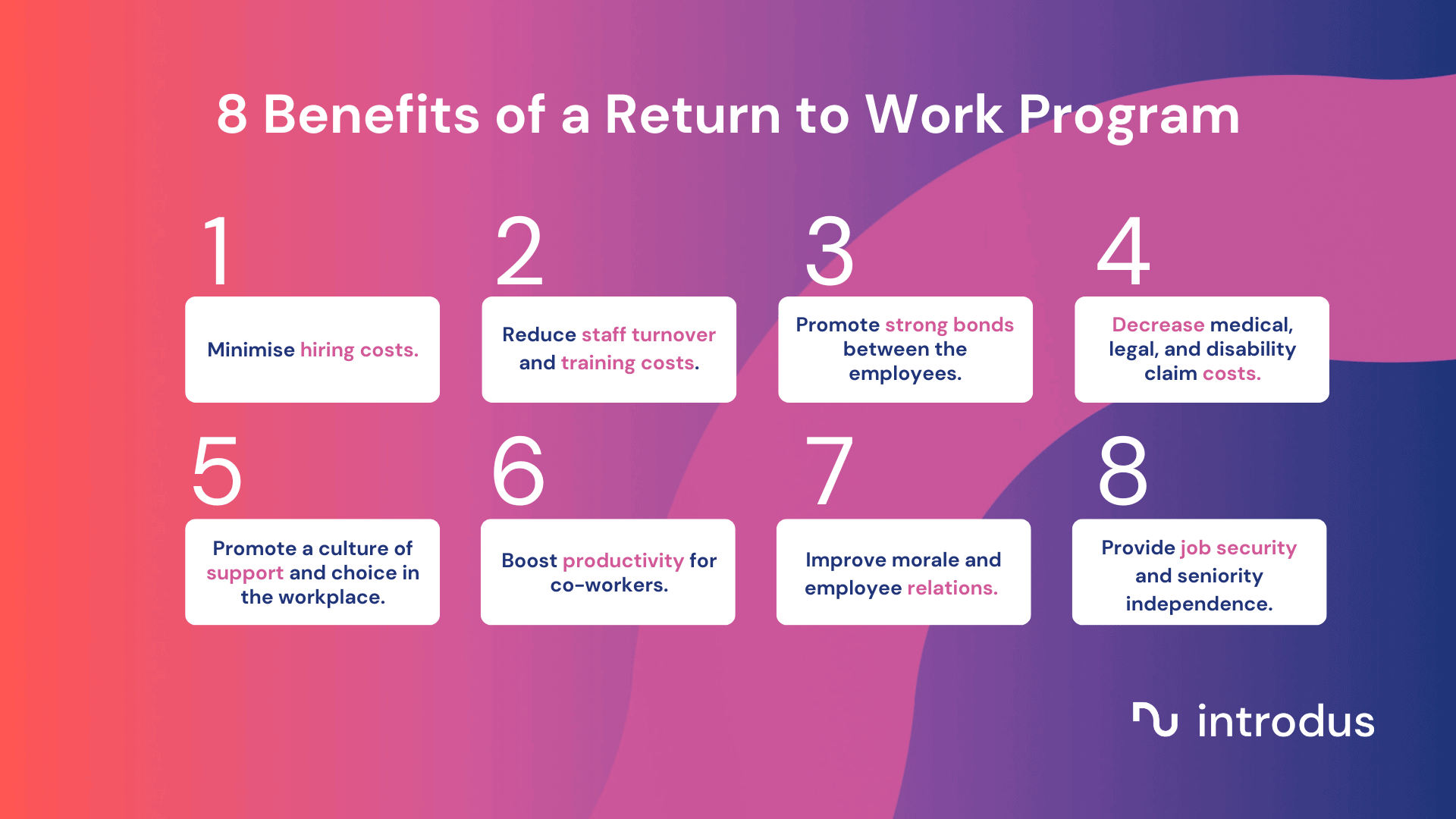
Crafting Effective Return to Work Programs: A Comprehensive Guide
The modern workplace is dynamic, and organizations must be prepared for various employee situations, including leaves of absence due to illness, injury, or other personal reasons. A well-structured return to work program is crucial for ensuring a smooth and successful transition for employees back into their roles. These programs not only support employee well-being but also benefit the organization by retaining valuable talent, reducing costs associated with extended leave, and boosting overall productivity. This comprehensive guide explores the key elements of creating and implementing effective return to work programs.
Understanding the Importance of Return to Work Programs
Return to work programs are more than just a formality; they are a strategic investment in an organization’s human capital. When employees take leave, maintaining a connection and providing support during their absence is essential. A formal return to work program demonstrates a commitment to employee well-being and helps facilitate a quicker and more comfortable reintegration into the workplace. Ignoring this aspect can lead to prolonged absences, decreased morale, and potential legal issues. Consider the impact on team dynamics and project timelines when an employee is out for an extended period. A structured program mitigates these disruptions.
Benefits for Employees
- Reduced Stress and Anxiety: Returning to work after a leave can be daunting. A well-defined program provides a clear roadmap and support system, easing anxiety and promoting confidence.
- Improved Physical and Mental Health: Gradual return to work allows employees to adjust to their roles without overwhelming their physical or mental capabilities.
- Enhanced Job Security: Demonstrates the employer’s commitment to supporting employees, fostering a sense of security and loyalty.
- Maintaining Connection: Staying connected with colleagues and workplace updates during leave can help ease the transition back.
Benefits for Employers
- Reduced Costs: Shortening leave durations and reducing the need for replacement hires.
- Improved Productivity: Retaining experienced employees and minimizing disruption to workflow.
- Enhanced Employee Morale: Showing care and support fosters a positive work environment.
- Legal Compliance: Adhering to relevant legislation and regulations regarding employee leave and accommodation.
Key Components of an Effective Return to Work Program
Developing a successful return to work program requires careful planning and consideration of various factors. Here are the essential components:
Clear Policy and Procedures
A clearly defined policy outlines the program’s objectives, eligibility criteria, roles and responsibilities, and procedures for managing employee returns. This policy should be readily accessible to all employees and managers. Include details such as the process for requesting leave, communication protocols during leave, and the steps involved in the return to work process.
Early Intervention and Communication
Proactive communication with employees during their leave is crucial. Regular check-ins, updates on workplace developments, and expressions of support can help maintain a connection and ease the transition back. Early intervention involves identifying potential barriers to return and addressing them proactively. This might include arranging workplace accommodations or modifying job duties. [See also: Managing Employee Absences Effectively]
Individualized Return to Work Plans
Each employee’s situation is unique, and a one-size-fits-all approach is unlikely to be effective. Developing individualized return to work plans that address specific needs and limitations is essential. These plans should be developed in consultation with the employee, their healthcare provider, and relevant stakeholders within the organization. Consider factors such as the nature of the employee’s illness or injury, their job duties, and any necessary accommodations.
Gradual Return to Work Schedules
A gradual return to work schedule allows employees to gradually increase their work hours and responsibilities over time. This approach helps prevent overwhelm and allows employees to adjust to their roles without jeopardizing their health or well-being. The schedule should be flexible and adaptable based on the employee’s progress and feedback.
Workplace Accommodations
Providing necessary workplace accommodations is a crucial aspect of facilitating a successful return to work. Accommodations might include modified job duties, ergonomic adjustments, assistive technology, or changes to the work environment. Employers have a legal obligation to provide reasonable accommodations to employees with disabilities, as long as these accommodations do not create undue hardship for the organization. [See also: Understanding Disability Accommodation in the Workplace]
Training and Support for Managers
Managers play a critical role in the return to work process. They need to be trained on the organization’s policy and procedures, as well as how to effectively support employees during their transition back to work. Training should cover topics such as communication skills, conflict resolution, and how to identify and address potential barriers to return. Managers should be equipped to provide empathy, understanding, and practical assistance to returning employees.
Monitoring and Evaluation
Regularly monitoring and evaluating the effectiveness of the return to work program is essential for continuous improvement. Track key metrics such as return-to-work rates, leave durations, and employee satisfaction. Gather feedback from employees and managers to identify areas for improvement. Use this data to refine the program and ensure it remains effective and relevant. This includes reviewing the program’s impact on productivity, morale, and cost savings.
Implementing a Return to Work Program: A Step-by-Step Guide
Implementing a return to work program requires a systematic approach. Here’s a step-by-step guide:
- Assess Current Practices: Evaluate your existing leave management policies and procedures to identify gaps and areas for improvement.
- Develop a Policy: Create a comprehensive return to work policy that outlines the program’s objectives, eligibility criteria, and procedures.
- Communicate the Policy: Communicate the policy to all employees and managers, ensuring they understand their roles and responsibilities.
- Train Managers: Provide training to managers on how to effectively support employees during their return to work.
- Develop Individualized Plans: Work with employees and their healthcare providers to develop individualized return to work plans.
- Provide Accommodations: Provide necessary workplace accommodations to support employee success.
- Monitor Progress: Regularly monitor employee progress and adjust plans as needed.
- Evaluate Effectiveness: Evaluate the effectiveness of the program and make adjustments for continuous improvement.
Addressing Common Challenges
Implementing a return to work program can present various challenges. Common challenges include:
- Resistance from Employees: Some employees may be reluctant to participate in the program due to concerns about privacy or fear of discrimination.
- Lack of Manager Support: Managers may be hesitant to provide accommodations or modify job duties due to workload concerns.
- Communication Barriers: Poor communication between employees, managers, and healthcare providers can hinder the return to work process.
- Legal Compliance Issues: Ensuring compliance with relevant legislation and regulations can be complex.
Addressing these challenges requires proactive communication, training, and a commitment to creating a supportive and inclusive work environment. It’s important to foster open dialogue and address concerns openly and honestly. Providing managers with adequate resources and support can help them overcome their hesitations. Maintaining clear and consistent communication channels is essential for ensuring a smooth and successful return to work process. [See also: Legal Considerations for Employee Leave]
The Future of Return to Work Programs
As the workforce evolves, return to work programs will continue to play a critical role in supporting employee well-being and organizational success. Future trends include:
- Increased Focus on Mental Health: Recognizing the importance of mental health and providing support for employees with mental health conditions.
- Greater Use of Technology: Leveraging technology to facilitate communication, track progress, and provide virtual support.
- Emphasis on Personalized Approaches: Tailoring programs to meet the unique needs of individual employees.
- Integration with Wellness Programs: Integrating return to work programs with broader wellness initiatives to promote overall employee health and well-being.
Conclusion
A well-designed and implemented return to work program is an investment in both employee well-being and organizational success. By providing support, accommodations, and clear communication, organizations can help employees successfully transition back to work after a leave of absence. This not only benefits employees by reducing stress and improving their health but also benefits the organization by retaining valuable talent, reducing costs, and boosting productivity. Embracing a proactive and compassionate approach to return to work is essential for creating a thriving and supportive workplace.

